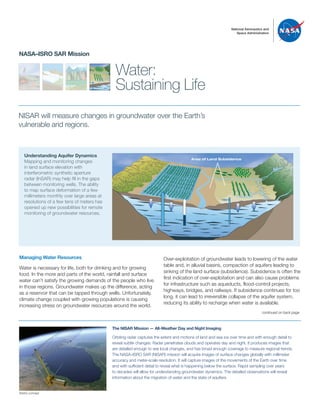
NISAR ( NASA-ISRO Synthetic Aperture Radar (NISAR) ) Water
- 1. National Aeronautics and Space Administration Water: Sustaining Life NASA–ISRO SAR Mission NISAR will measure changes in groundwater over the Earth’s vulnerable arid regions. Over-exploitation of groundwater leads to lowering of the water table and, in alluvial basins, compaction of aquifers leading to sinking of the land surface (subsidence). Subsidence is often the first indication of over-exploitation and can also cause problems for infrastructure such as aqueducts, flood-control projects, highways, bridges, and railways. If subsidence continues for too long, it can lead to irreversible collapse of the aquifer system, reducing its ability to recharge when water is available. Understanding Aquifer Dynamics Mapping and monitoring changes in land surface elevation with interferometric synthetic aperture radar (InSAR) may help fill in the gaps between monitoring wells. The ability to map surface deformation of a few millimeters monthly over large areas at resolutions of a few tens of meters has opened up new possibilities for remote monitoring of groundwater resources. Managing Water Resources Water is necessary for life, both for drinking and for growing food. In the more arid parts of the world, rainfall and surface water can’t satisfy the growing demands of the people who live in those regions. Groundwater makes up the difference, acting as a reservoir that can be tapped through wells. Unfortunately, climate change coupled with growing populations is causing increasing stress on groundwater resources around the world. The NISAR Mission — All-Weather Day and Night Imaging Orbiting radar captures the extent and motions of land and sea ice over time and with enough detail to reveal subtle changes. Radar penetrates clouds and operates day and night. It produces images that are detailed enough to see local changes, and has broad enough coverage to measure regional trends. The NASA–ISRO SAR (NISAR) mission will acquire images of surface changes globally with millimeter accuracy and meter-scale resolution. It will capture images of the movements of the Earth over time and with sufficient detail to reveal what is happening below the surface. Rapid sampling over years to decades will allow for understanding groundwater dynamics. The detailed observations will reveal information about the migration of water and the state of aquifers. continued on back page TO REDRAW Area of Land Subsidence Artist’s concept
- 2. For more information, visit: http://nisar.jpl.nasa.gov JPL 400-1598 Rev. 1 12/16 National Aeronautics and Space Administration Jet Propulsion Laboratory California Institute of Technology Pasadena, California www.nasa.gov Subsidence As a Measure of Groundwater Depletion Water resource managers need to measure areas of continuing subsidence and detect new regions of compaction in order to adapt to changing water supply conditions and preserve the integrity of the aquifers for future generations. Subsidence permanently damages the aquifer, decreasing the amount of water that can be stored. Land subsidence is typically measured though periodic leveling or GPS surveys along with limited monitoring wells, but the lack of frequent measurements and the difficulty of mandating measurements at private wells result in datasets that are sparse in space and time. NISAR will provide systematic measurement across entire aquifers. Managing Water Globally NISAR offers the promise of detecting and measuring changes to the land surface height above nearly every aquifer in the world. This will provide information for large segments of the global population that depend on groundwater to bridge gaps in surface and rain water supply. It may allow us for the first time to indirectly measure the volume of groundwater that is pumped and recharged around the world. This will become more important as Earth’s changing climate and the growing global population outpaces the world’s supply of fresh water in aquifers. Another capability of NISAR is its ability to easily identify and map the extent of surface water in lakes and rivers. NISAR can be used to track floods, even under cloud cover and vegetation canopies. In some cases, NISAR can be used to measure changes in the water surface height as water levels change with rainfall, evaporation, and usage. continued from front page Copyright 2016 California Institute of Technology. U.S. Government sponsorship acknowledged. Monitoring Subsidence Total subsidence in the San Joaquin Valley, California, from 2007 to 2011 measured by InSAR. The subsidence bowl to the north, just south of Merced, is a relatively recent feature caused by a change from row crops to trees, which use more groundwater. Note how the California Aqueduct (purple) and the proposed High Speed Rail (blue) are both affected by subsidence. NISAR will provide this information on a regular basis.
